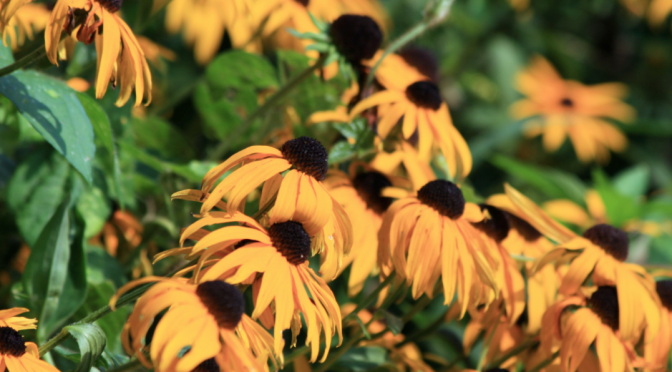Many of our readers have asked for more information on drought-tolerant, native perennials. Native perennials are ideal for providing nectar, pollen, seeds, and habitat for native butterflies, bees, and other insects and animals. They’re also a low-maintenance choice for your garden. Native varieties are well adapted to local soil and climatic conditions. They typically require less watering and fertilizing than other cultivated varieties. They’re also more tolerant of local pests and tend to withstand weed pressure well, making them perfect for busy gardeners. Here are a few of our favorites.
Rudbeckia
Often called Black-eyed Susans these charming yellow flowers are a hardy, drought-tolerant perennial. They self-seed readily and naturalize aggressively. Be sure to plant them in an area you don’t mind them expanding. Birds like goldfinches love the seeds.
Echinacea
Another awesome native perennial is echinacea. Once established they’re quite drought tolerant, hardy, and may self-seed. We carry four echinacea varieties, Echinacea augustifolia, Echinacea pallida, Echinacea paradox, and Echinacea purpea. All four varieties are medicinal and excellent in teas and tinctures. The roots, leaves, and flowers can all be used. Echinacea has immune boosting, antibacterial, and antiviral properties. Paradoxa is the only yellow variety. Note that every variety but purpea needs cold stratification to germinate.
Echinacea is also attractive to native wildlife. Pollinators love Echinacea and some songbirds species enjoy the seeds in the late summer and fall. Leaving the dead flowers standing can help encourage birds to visit.
Bergamot (Monarda)
Also called Bee Balm, this is another useful flower to have growing on your property. Hummingbirds, butterflies, and bees love bee balm. We carry two varieties, Lemon Bergamot and Wild Bergamot. Lemon Bergamot leaves are great for flavoring meat or fish. Both varieties make delicious tea and have medicinal properties. Several Native American tribes used bergamot as a carminative.
Butterfly Weed
Though it may take up to two years for this plant to become established from seed, it’s well worth the wait. These brilliant orange flowers will attract butterflies, bees, and birds to your garden throughout the growing season. Once established, butterfly weed is very drought-tolerant and will self-seed. They do best in well-drained soil with full sun. For best results, sow in the fall.
Daylillies
Daylillies are super easy to grow and quite hardy. The orange daylilly is a native species and can store water in its roots. While you can purchase bulbs, Day Lillies spread readily and are pretty easy to find for free. Try asking a friend or connecting with a local gardening group. Additionally, the flowers, flower buds, young stalks, and root tubers are all edible.
Yarrow
Another great medicinal flower, yarrow is another plant that’s easy to find for free. You’ll often find plants growing in hayfields that can be easily transplanted (always get permission of course). Yarrow’s latin name Achillea millefolium comes from it’s historic usage. Yarrow has been shown to staunch blood flow and was reportedly used by the legendary figure Achilles to treat battle wounds. Yarrow also helps attract beneficial insects and pollinators and many permaculturalists consider it a “dynamic accumulator,” meaning that it brings nutrients from to in the soil to the surface for other plants to access.
Other tips for making your garden drought-tolerant:
- use natural mulch like straw, wood chips, or leaves whenever possible
- plant cover crops which add organic matter and keep the soil cool and moist
- add organic matter like compost to your soil so that it holds water well
- utilize gray-water from sinks and showers if possible
- create permanent beds and paths and don’t water paths
- when you need to water use drip irrigation and/or water in the early morning or evening to avoid evaporation

